As one of the world's great natural
harbors, Sevastopol has been a prize in both peace and
wartime. Peaceful silos remind us that Ukraine has long been
a breadbasket and Sevastopol its path to move the grain to hungry
cities. throughout the war. Warrior ships (90%
Russian, 10% Ukraine) harbor here in this formerly closed
city. Uneasy over the recent Georgian conflict, Ukraine's
president
is
now
trying to score political points with the West by threatening to
renegotiate
the agreement to harbor Russian ships here. Ukraine
has the second largest army in Europe. Second to its big Rus'
brother who is unlikely to give up its premier warm water port. The
Crimea is filled with Russian speakers (and
sympathizers).
Given the Ukraine's thirst for Russian oil, it's unlikely the Russian
fleet
will be moving anytime soon.
Chersonesos
Long before fossil oil was useful,
this site was known for another liquid, its wine, as well as its grain.
The Greeks exploited this fertile place with a great harbor
and established the colony of Chersonesos in the 6th century,
BC. For nearly 2 millennia, it survived until descendants of Genghis
Khan forced its abandonment in 1299. Today it has its own
Orange Revolution as the The University of Texas at
Austin’s Institute of Classical
Archeology leads excavation
efforts along with Ukraine and
Sevastopol
governmental and museum authorities.
The picture below shows the remains
of
a 6th century AD building, most likely the work of the Byzantines who
inherited
Chersonesos from
the Romans. This site is considered the birthplace of Slavic
Archeology and a sketch of this basilica adorns the back of the basic
Ukraine currency, the 1 Hryvnia note.
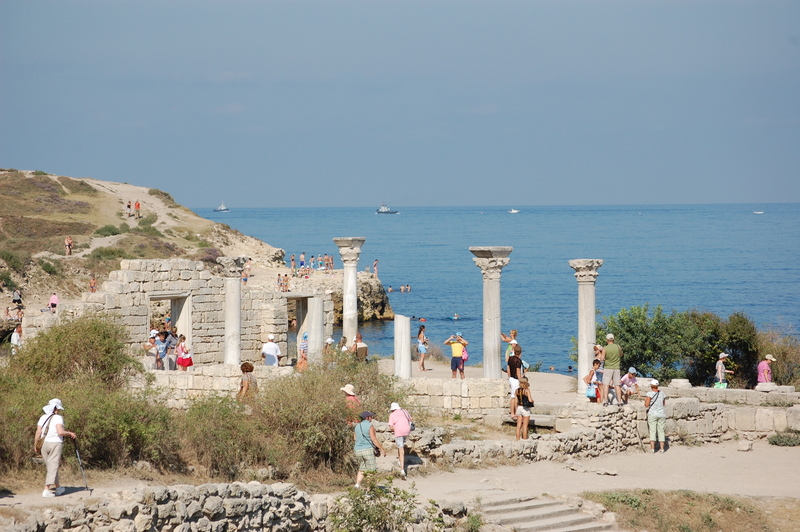
Chersonesos: A beach for
the natives; a Greek ruin for the tourists
Named after the year of its founding, the 1935 Basilica
sports inscriptions suggesting that a Jewish synagogue was
nearby. In the
distance, the picture shows scanty beaches as erosion provides little
room for bathers. In the middle ground we see this site flush
with tourists -- a mixed blessing as they make the site more attractive
in the competition for research funds but their numbers
threaten the fragile
remains.
The Greek word chersonesos
means peninsula.
The much larger Heraklean Peninsula that surrounds this site was
covered with farm area (called chora) linked by an
elaborate network
of roads to bring the grain and wine to market -- and to the harbor to
export
to Athens.
Chersonesos will
probably
turn out to be as
significant an archaeological site as Italy's Pompey. Both Pompey and
Chersonesos were
frozen in time by disasters. While Pompey
tells us
much about Roman city life in the first century AD, Chersonesos will
reveal the
secrets of
agriculture.
Most sites are lucky to have buried cities; remains of their
countryside life have long been
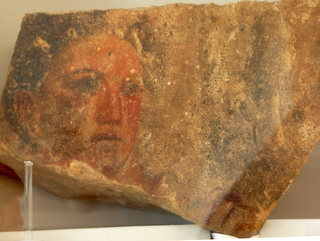
destroyed by plows
and then by 20th
century suburban
development. Not so here in the closed city of
Sevastopol. So far, about
a third of the site has been excavated and many more clues to the Greek
4th
century BC farm life sleep just below the topsoil.
The uncovered exterior remains are extensive, but
the jewels of this collection are kept in a small museum that serves as
a work area for researchers and restorers. These are gravestones, many
holding some of their original
polychrome
colors as shown in the photo at upper right. Apparently these were
taken from a necropolis and used to help
build
the city walls before being rescued by archaeologists. Unlike
most other necropolis headstones, they
appear to be dedicated to individuals, rather than whole families. Over
300
fragmentary stelai were recovered during Soviet times.
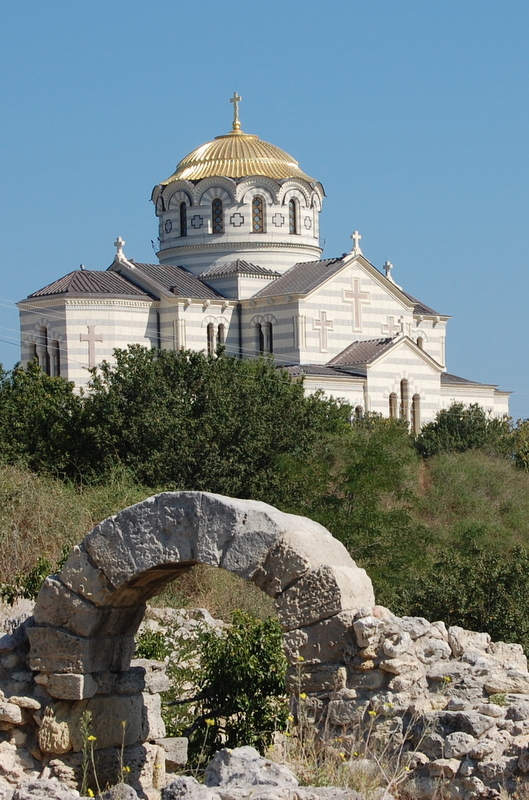
At left, we see the
domed St. Vladimir
cathedral rising above a decidedly Roman arch framing a gate in the
city walls. This late 19th century building marks
the spot where the Russian and Ukraine Orthodox churches began about at
the end of the first millennium AD.
About this time, Chersonesos was a major Byzantine outpost and
therefore a focus for interactions between the Christian West and the
pagan
Slavs. So here it was that Vladimir the Great converted to
Christianity which led to sainthood and cathedraldom.
Vladimir was not fast tracked for sanctity. Upon becoming
king
in Kiev, he first tried to restore paganism, possibly including rituals
involving human sacrifice. When that failed to excite the people, he
set up a
task force to see which monotheistic religion all should adopt.
Choices were
Judaism, Islam,
or Christianity. When Christianity won, Vladimir
traded in his 7 wives for a Constantinople princess, and converted
at the
same time.
Panorama
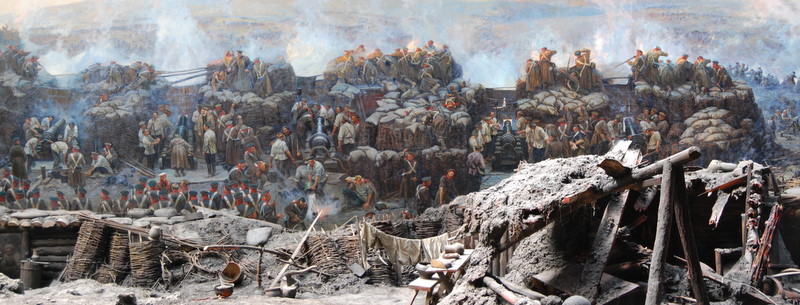
A scene from the 377-foot diorama
Next we visited the diorama museum commemorating the first great siege
of Sevastopol: September 1854 until September 1855 during the Crimean
war. The museum originally opened on the 50th anniversary of
the siege, 1905. Unfortunately, during WWII, the German
one-month-long siege destroyed the mural beyond recovery.
We saw a faithful post-war recreation by Soviet
artists.
This wraparound mural superbly depicts one day of the siege: June 18,
1855, when the Russians successfully repelled the assault. (While they
won that day, they eventually lost Sevastopol -- and the war.) When the
Tsar realized how poorly his serfs fought against freemen on the
British and French side, he moved to emancipate the serfs.
In the scene depicted above, Russian sailors load cannons taken from
their scuttled ships while a famous hero pours water on a newly-landed
bomb. Typically the enemy would bombard their positions all day, and
the Russians would rebuild overnight. Note how the
fortification sculptures of the foreground blend seemlessly into the
picture, giving viewers an almost 3D feel that they are
standing inside the Russian positions.
Hansaray (Khan Palace) at Bakhchisaray


Above
the Hansaray courtyard with the Crimean mountains rising behind; below,
the North Gate of the palace
Our afternoon found us at Hansaray in the Crimean town of Bakhchisaray.
Here we visited the only remaining palace of the Crimean
Khans, a political entity which lasted from 1441 to 1783 when
Catherine the Great forced the area into the Russian fold. Tracing
roots back to Genghis Khan's empire, these Khans controlled most of
Crimea excluding its southern ports which were run by the Genoans.
(Steppe laws of succession required the Khan to be a descendant of
Genghis Khan. Even the Russian Tsars followed this rule.)
Technically the Ottomans were their masters, and had to approve (but
not nominate) a new Khan. In reality, the Giray dynasty were
treated as
equals by Istanbul's rulers -- and the Girays treated Russia as a
doormat, raiding it often and taking as many as 3 million slaves.
Girays ruled until the late 18th century and their descendants are
alive today.
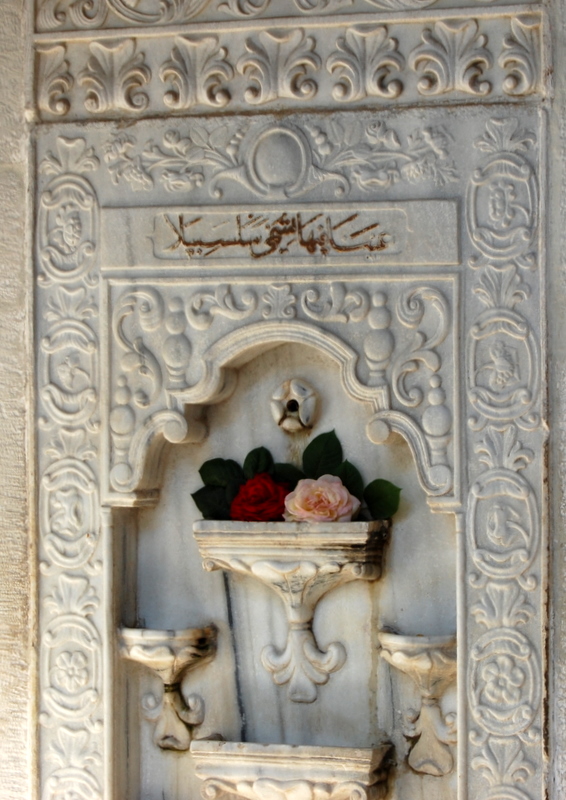
Founded by Khan Sahib I Giray in 1532, the Crimean Tatar Bakhchisary
Palace was built with slave labor in the 16th century (and restored
since to resemble how it looked then). Today its walls
encircle the Khan's quarters and state rooms, a harem, mosque,
falconry, cemetery, garden, and several other buildings.
After touring several Ottoman palaces in Istanbul, we expected the Khan
palace to be more elaborate. After all, the Crimean Khanate
was one of the dominant powers in Eastern Europe until the 18th
century.
The most famous piece of sculpture here is the Bakhchisaray Fountain or
the Fountain of Tears shown at right. Built in 1764, it stood at the
tomb of the Khan's favorite concubine. In 1784, it was moved to the
north side of the Ambassador's court. After an 1820 visit, an exiled
Pushkin composed a love poem making it forever famous. Some feel
Pushkin's work helped preserve the palace after Catherine the Great
took over the Crimean. The place was then in need of Pushkin -- many of
the Khans had been poets.
